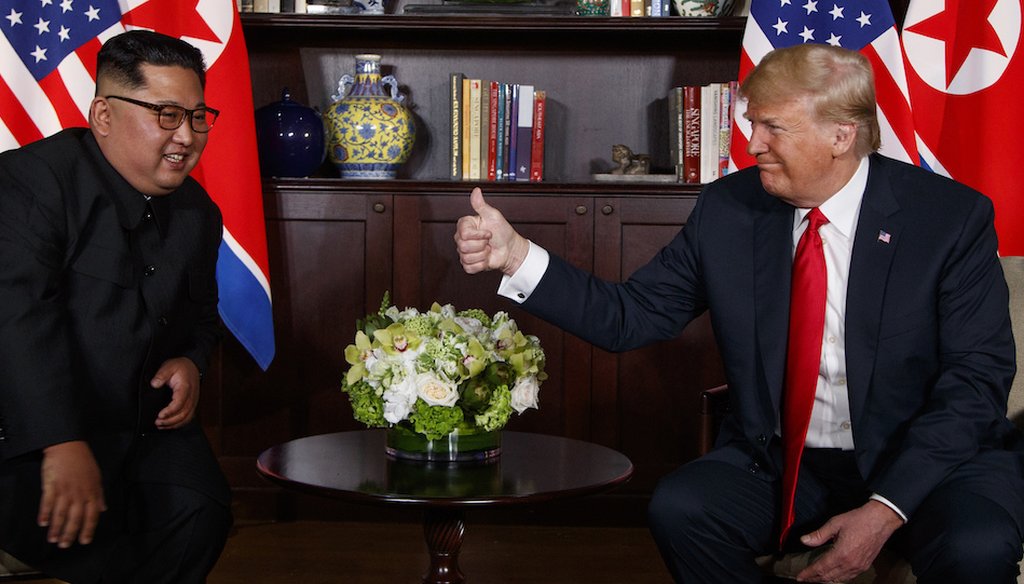Get PolitiFact in your inbox.

President Donald Trump meets with North Korean leader Kim Jong Un on Sentosa Island June 12, 2018, in Singapore. (AP)
President Donald Trump and North Korea’s Kim Jong Un adopted an upbeat tone as they opened a new chapter in their tense courtship, with both leaders broadly agreeing at a historic Singapore summit to pursue a path toward more peaceful relations.
Given Pyongyang’s strides toward developing a nuclear-tipped missile capable of reaching the United States, the question of whether an arms control deal would take shape loomed large over the talks.
Both leaders signed a joint statement that experts characterized as aspirational but short on specifics. The "true test of success" will be whether the two countries agree in follow-on talks about the details of denuclearization, including verifiable steps to show North Korea is reducing its nuclear threat, said Kelsey Davenport, nonproliferation policy director at the Arms Control Association.
"The critical question is what comes next?" she said.
As the world watches to see if the summit produces tangible results, here's what you need to know.
In their joint statement, Trump and Kim committed to "work toward complete denuclearization of the Korean Peninsula."
To date, North Korea is believed to possess up to 60 nuclear warheads. The country has conducted six nuclear tests and more than 100 missile tests, including intercontinental missiles.
Experts said the agreed-to language is light on details and leaves plenty of room for interpretation.
Stephan Haggard, professor of Korea-Pacific studies at the University of California-San Diego, cautioned that we don’t know everything that was said, but he is troubled by a notable omission.
"The statement makes no reference to the formula of ‘complete, verifiable, irreversible denuclearization,’ promising only to work towards denuclearization of the Korean peninsula, a formulation favored by the North Koreans," Haggard said. "It is possible that there were agreements reached in Singapore that we have not yet seen. But the document provides no insight into the subsequent process and does not contain any substantive commitments from North Korea."
It’s unclear whether the meeting helped bridge the gap in how the United States and North Korea define their terms.
"When the North Koreans say complete denuclearization, they mean the removal of the threat of nuclear war by both North Korea and the United States," said Joseph DeThomas at the Penn State School of International Affairs. "This means the removal of nuclear capable systems such as aircraft, ships and submarines from the Korean Peninsula and the area around it, as well as the eventual removal of North Korean nuclear weapons at a time North Korea feels safe. They have sometimes included an end to the U.S. nuclear guarantee to South Korea or the end of the U.S.-ROK alliance."
Marcus Noland of the Peterson Institute for International Economics saw nothing new from the North Korean side.
"That statement is consistent with past North Korean statements that it was willing to give up nuclear weapons if the United States was also willing to give up nuclear weapons," said "Effectively, zero for zero."
Frank Jannuzi, president of the Mansfield Foundation, said the joint statement left denuclearization undefined in critical ways.
"Does denuclearization preclude uranium enrichment?" Jannuzi said. "Peaceful nuclear power? What about production of medical isotopes and other peaceful uses of nuclear physics?"
The joint statement said Trump was "committed to provide security guarantees."
In the art of diplomacy, the phrase "security guarantees" typically refers to statements the United States could make about a shift in foreign policy, DeThomas said.
Trump initially told reporters, "We will stop the war games," a reference to military exercises conducted by the U.S. and South Korean militaries.
Trump called the exercises "provocative," adding, "Under the circumstances we are negotiating a comprehensive and complete deal. It is inappropriate to have war games. No. 1, we save money. A lot. No. 2, it is really something they very much appreciated."
However, an end to the U.S.-South Korean exercises was not included in the joint statement Trump and Kim released after the summit, and it’s unclear whether it will happen.
Trump also dangled the possibility of eventually removing the roughly 30,000-strong U.S. military contingent stationed in South Korea. However, he added that currently "that’s not part of the equation."
Sen. Lindsey Graham, R-S.C., who sits on the Senate Armed Services Committee, downplayed the significance of suspending joint military exercises, but cautioned against removing U.S. forces from the peninsula.
"I don’t think canceling a war game is going to matter over the arc of time," Graham said on NBC’s Today show.
"The one thing that I would violently disagree with is removing our troops," he added. "I can’t imagine I would vote for any agreement that requires us to withdraw our forces because that would destabilize Asia. That’s what China wants. That doesn’t make the world more peaceful, it makes it more dangerous."
The United States has applied decades of diplomatic engagement and international pressure on three generations of North Korean leaders — from Kim Il Sung to Kim Jong Il to Kim Jong Un, the regime’s current leader.
Earlier in Trump’s presidency, a meeting with Kim seemed unthinkable, as the two leaders traded barbs, with Trump referring to Kim as ‘Little Rocket Man" and Kim slamming Trump as a feeble-minded "dotard." Relations appeared to reach a boiling point when Trump threatened to unleash "fire and fury."
So perhaps the most extraordinary breakthrough is the fact that the meeting happened — and even produced a conciliatory, if vague, agreement.
"The most significant development is that it happened at all and that it opened up a pathway for real negotiations on specific, concrete agreements," DeThomas said. "Creating this process greatly reduces the risk that the two sides would feel there was no option but to go to war."
The tonal shift in the relationship — from saber-ratting to face-to-face meeting — is no small feat, Jannuzi said.
"Adopting a less confrontational tone and pledging to hold follow-up meetings assures that we are now at the beginning of a process that is likely to take months if not years to reach the ultimate goals of peace and denuclearization," he said.
Our Sources
Joint statement of President Donald Trump Chairman Kim Jong Un, June 12, 2018
Email interview, Kelsey Davenport, nonproliferation policy director at the Arms Control Association, June 12, 2018
Email interview, Joseph DeThomas, professor of international affairs at Penn State University, June 12, 2018
Email interview, Frank Jannuzi, president Mansfield Foundation, June 12, 2018
Email interview, Marcus Noland, executive vice president of the Peterson Institute for International Economics, June 12, 2018
Email interview, Stephan Haggard, professor of Korea-Pacific studies at the University of California-San Diego, June 12, 2018



















































